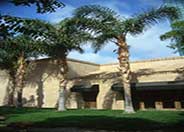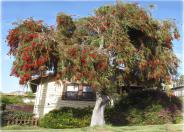
Common name:Queen Palm
Botanical name:Syagrus romanzoffianum
This palm has a very straight trunk to about 50' in height. It has arching, feathery, bright green, glossy leaves that can be 10'-15' long. It is fragile in heavy winds and a fast grower. It will become damaged in temperature below 24 degrees F.

Common name:Weeping Bottlebrush
Botanical name:Callistemon viminalis
Weeping Bottlebrush (Callistemon viminalis) is a dense canopied tree with bright red, bottlebrush flowers that emerge in the spring and summer. This tree is native to Australia and does extremely well in California-friendly gardens. It can reach up to 20' tall and wide but can be kept smaller with the help of a licensed arborist. This tree is typically a single trunk, and the canopy can be thinned out to allow sunlight into the interior, which will encourage more blooming. Maintenance on the tree is low, but the leaf and flower litter may require more upkeep. This tree is best planted in a location where the leaf and flower droppings can stay in place and become part of the mulch. If there are under-plantings or this tree is over a seating area, it is not uncommon for everything underneath to have a red glow from all the fallen flower petals. This tree should be planted at least five feet away from any hardscape areas and 10 feet from structures such as houses and buildings. Shrubs and perennials should be planted about three feet away from this tree. It should be irrigated for about 45 minutes once a week when using most in-line drip irrigation systems.

Common name:Star Jasmine, Maile Haole
Botanical name:Trachelospermum jasminoides
Star Jasmine is an evergreen vine that grows 20' tall or a ground cover that reaches 1'-2' tall and 4'-5' wide. It has white fragrant flowers in the summer and can tolerate sun or partial shade. The star jasmine needs regular watering. Leaves are dark green, oval, thick, about 2" long. This is a great plant on a trellis, in containers or in a parking strip.
Photographer: GardenSoft
Practice grass-cycling by leaving short grass clippings on lawns after mowing, so that nutrients and organic matter are returned to the soil.
Mulching and adding compost to soil can minimize evaporation and help soil absorb and store water.
Drip and other smart irrigation delivers water directly to roots, allowing no excess water for weeds.